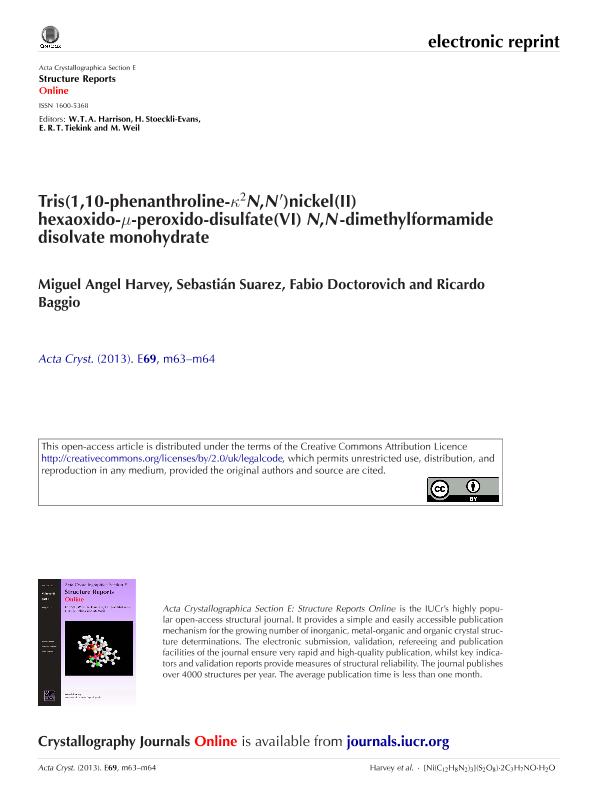Mostrar el registro sencillo del ítem
dc.contributor.author
Harvey, Miguel Angel

dc.contributor.author
Suarez, Sebastian

dc.contributor.author
Doctorovich, Fabio

dc.contributor.author
Baggio, Ricardo Fortunato

dc.date.available
2015-11-12T13:57:16Z
dc.date.issued
2013-01
dc.identifier.citation
Harvey, Miguel Angel; Suarez, Sebastian; Doctorovich, Fabio; Baggio, Ricardo Fortunato; Tris(1,10-phenathroline-k2N,N')-nickel(ii) hexaoxido-μ-peroxido-disulfate(vi) N,N-dimethylformamide disolvate monohydrate; Wiley Blackwell Publishing, Inc; Acta Crystallographica Section E; 69; 1; 1-2013; 1-16
dc.identifier.issn
1600-5368
dc.identifier.uri
http://hdl.handle.net/11336/2744
dc.description.abstract
The asymmetric unit of the title complex, [Ni(C12H8N2)3]- S2O82C3H7NOH2O, consists of a complex [Ni(phen)3]2+ cation and one isolated pds anion, with two DMF molecules and one water molecule as solvates (where phen is 1,10- phenanthroline, pds is the hexaoxido--peroxoido-disulfate dianion and DMF is dimethylformamide). The [Ni(phen)3]2+ cation is regular, with an almost ideal NiII bond-valence sum of 2.07 v.u. The group, as well as the water solvent molecule, are well behaved in terms of crystallographic order, but the remaining three molecules in the structure display different kinds of disorder, viz. the two DMF molecules mimic a twofold splitting and the pds anion has both S atoms clamped at well-determined positions but with a not-too-well-defined central part. These peculiar behaviours are a consequence of the hydrogen-bonding interactions: the outermost SO3 parts of the pds anion are heavily connected to the complex cations via C?H O hydrogen bonding, generating an [Ni(phen)3]pds network and providing for the stability of the terminal pds sites. Also, the water solvent molecule is strongly bound to the structure (being a donor of two strong bonds and an acceptor of one) and is accordingly perfectly ordered. The peroxide O atoms in the pds middle region, instead, appear as much less restrained into their sites, which may explain their tendency to disorder. The cation?anion network leaves large embedded holes, amounting to about 28% of the total crystal volume, which are occupied by the DMF molecules. The latter are weakly interacting with the rest of the structure, which renders them much more labile and, accordingly, prone to disorder.
dc.format
application/pdf
dc.language.iso
eng
dc.publisher
Wiley Blackwell Publishing, Inc

dc.rights
info:eu-repo/semantics/openAccess
dc.rights.uri
https://creativecommons.org/licenses/by-nc-sa/2.5/ar/
dc.subject
Ni(C12h8n2)3]S2o8·2c3h7no·H2o
dc.subject.classification
Química Inorgánica y Nuclear

dc.subject.classification
Ciencias Químicas

dc.subject.classification
CIENCIAS NATURALES Y EXACTAS

dc.title
Tris(1,10-phenathroline-k2N,N')-nickel(ii) hexaoxido-μ-peroxido-disulfate(vi) N,N-dimethylformamide disolvate monohydrate
dc.type
info:eu-repo/semantics/article
dc.type
info:ar-repo/semantics/artículo
dc.type
info:eu-repo/semantics/publishedVersion
dc.date.updated
2016-03-30 10:35:44.97925-03
dc.journal.volume
69
dc.journal.number
1
dc.journal.pagination
1-16
dc.journal.pais
Reino Unido

dc.journal.ciudad
Londres
dc.description.fil
Fil: Harvey, Miguel Angel. Consejo Nacional de Investigaciones Científicas y Técnicas. Centro Nacional Patagónico; Argentina. Universidad Nacional de la Patagonia "San Juan Bosco". Facultad de Ciencias Naturales - Sede Trelew; Argentina
dc.description.fil
Fil: Suarez, Sebastian. Consejo Nacional de Investigaciones Científicas y Técnicas. Oficina de Coordinación Administrativa Ciudad Universitaria. Instituto de Química, Física de los Materiales, Medioambiente y Energía; Argentina
dc.description.fil
Fil: Doctorovich, Fabio. Consejo Nacional de Investigaciones Científicas y Técnicas. Oficina de Coordinación Administrativa Ciudad Universitaria. Instituto de Química, Física de los Materiales, Medioambiente y Energía; Argentina
dc.description.fil
Fil: Baggio, Ricardo Fortunato. Comisión Nacional de Energía Atómica. Centro Atómico Constituyentes. Gerencia de Investigación y Aplicaciones; Argentina
dc.journal.title
Acta Crystallographica Section E

dc.relation.alternativeid
info:eu-repo/semantics/altIdentifier/doi/http://dx.doi.org/doi:10.1107/S1600536812050775
dc.relation.alternativeid
info:eu-repo/semantics/altIdentifier/url/http://scripts.iucr.org/cgi-bin/paper?S1600536812050775
Archivos asociados
